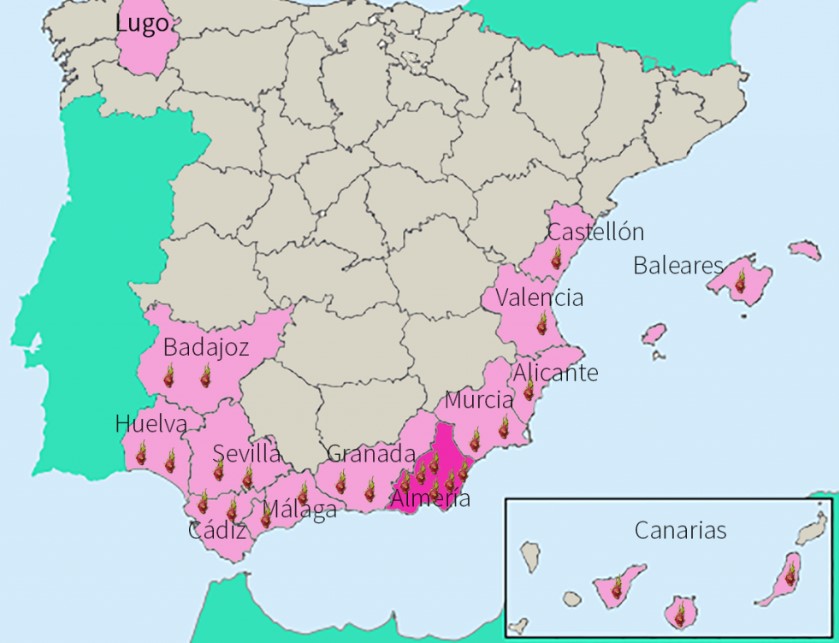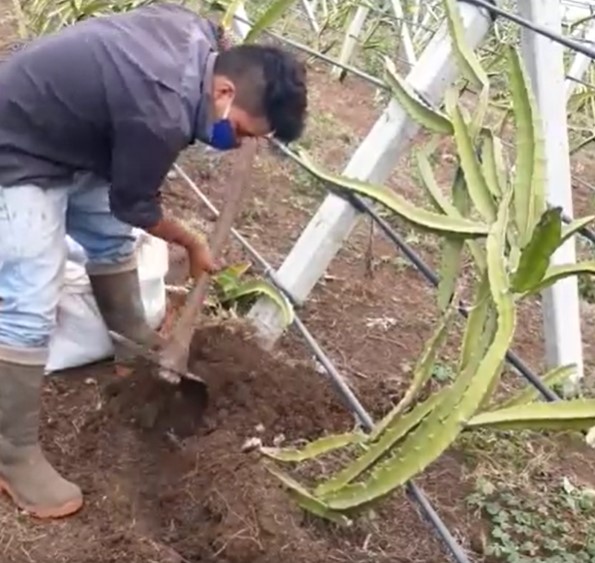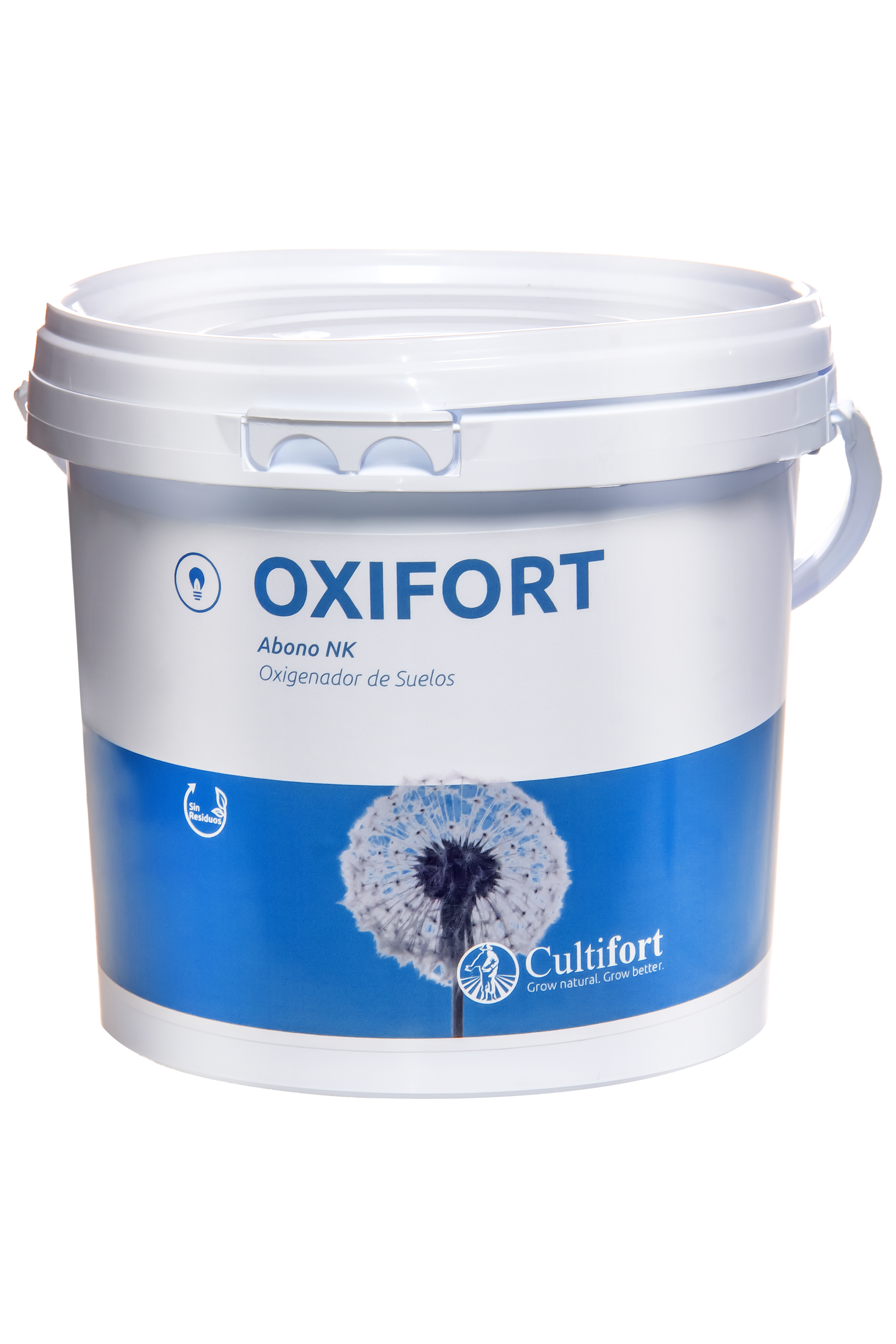1. BACKGROUND, CURRENT SITUATION IN SPAIN
The pitaya or dragon fruit originates from Central America (Mexico), although it was also standardized in South American countries such as Brazil and Ecuador, and to a lesser extent in Asian countries such as Thailand or Vietnam.
Spain, specifically the southern region of the Iberian Peninsula, has implemented an adaptation plan due to its climatic and soil variables for the proper productive performance of this crop, driven by an increase in demand based on its organoleptic and nutritional characteristics. It is rich in vitamins B and C, polyphenols, anti-inflammatories, and has the ability to stimulate collagen production.
Another key factor for its cultivation and adaptation at the national level is its easy management at low costs, which currently implies an interesting return on investment for the producer, reaching peaks in the market of up to €25/kg.
As for the areas where this crop is adapted, we can centralize them in the following:

2. AGROCLIMATIC MANAGEMENT NEEDS
2.1. Climate Requirements. Temperature and Radiation
Considering that this crop belongs to the cactus family, its development occurs under 35% shading, close to which it achieves its maximum net CO2 absorption rate, resulting in optimal vegetative growth (Tomaz de Oliveira & et al, Shade improves growth, photosynthetic performance, production and postharvest quality in red pitahaya (Hylocereus costaricensis), 2021).
In terms of temperature, it adapts well to a range between 15°C and 25°C, making subtropical climates like the coast of Granada and Malaga, followed by Murcia and Almeria, suitable as seen. However, special attention must be paid to radiation levels as its stems may be sensitive to burns, with exposure not exceeding 2200 mmol/m2 (Hernández, 2016).
2.2. Water Requirements
This is one of the main variables of interest that is concentrated in areas such as Almeria and Murcia.
Previous studies recommend water allocations ranging from 500 to 1500 mm/year depending on the physiological state and management, as it is recommended to lower this allocation to induce flowering for an average of 30 to 35 days (Magraner Mifsud, 2020).
2.3. Nutritional and Soil Requirements
This is one of the most relevant variables in its management and productive success.
Sandy-loam soil textures with excellent drainage capacity and significant organic matter content are recommended, with pH levels between 5.5 and 6.5, rich in nitrogen and potassium. Poorly drained soils may lead to root rot due to waterlogging. Considering that the pitaya originates from tropical habitats with soils featuring high moisture retention, active beneficial microorganism populations, and an excellent carbon/nitrogen ratio, specific control and analysis will be required in managing these variables.

From CULTIFORT, we want to propose a series of strategies to adapt soil conditions in order to impact these variables.
Regarding the soil variable, we want to emphasize the continuous application of OXIFORT.
OXIFORT, through the progressive release of oxygen nano bubbles, achieves a balance in the mass-volume relationships that define many physical properties of the soil, including porosity, soil bulk density, and the relative proportions of water and air occupying pore space in soil.
Through the application of OXIFORT, soil is obtained with well-aggregated structure, balancing large pores for aeration and drainage, and small pores for water retention. Good soil structure is associated with small to medium-sized aggregates with abundant pores both within and between aggregates, while avoiding compaction that hinders effective irrigation water flow through the root zone, which can be a stress factor for pitaya.
In light of the above, OXIFORT increases the pitaya’s responsiveness to stress situations, enhancing its tissue’s ability to transport metabolites quickly and incorporate them into specific metabolic pathways. However, even if the pitaya plant has the capacity to produce necessary substances (through excessive energy consumption) to defend and overcome stress, if it is not facilitated to transport these substances quickly enough to act rapidly without radically affecting its physiological processes, there is no possibility of efficient competition in the ecosystem and developing maximum productivity.
Other benefits of soil structuring, based on achieving balance in its aggregates and in association with the management of this crop, include:
- Improves water storage in the soil and, therefore, its efficient use.
- Increases the amount of available water in the soil, thereby increasing infiltration.
- Maintains proper mobility of water and gas flow, directly correlating with crop growth and yield.
- Optimal balance between adhesive and cohesive forces responsible for water retention in soils.
- Balance between field capacity, permanent wilting point, and available water storage (or plant-available water) for optimized management.
- Optimal balance between adhesive and cohesive forces responsible for water retention in soils, as well as its cation exchange capacity and C/N ratio.
- Optimal balance between field capacity, permanent wilting point, and available water storage (or plant-available water) for optimized management.
- Optimal available water storage capacity (AWSC).
- Optimal water storage balance (ΔS).



